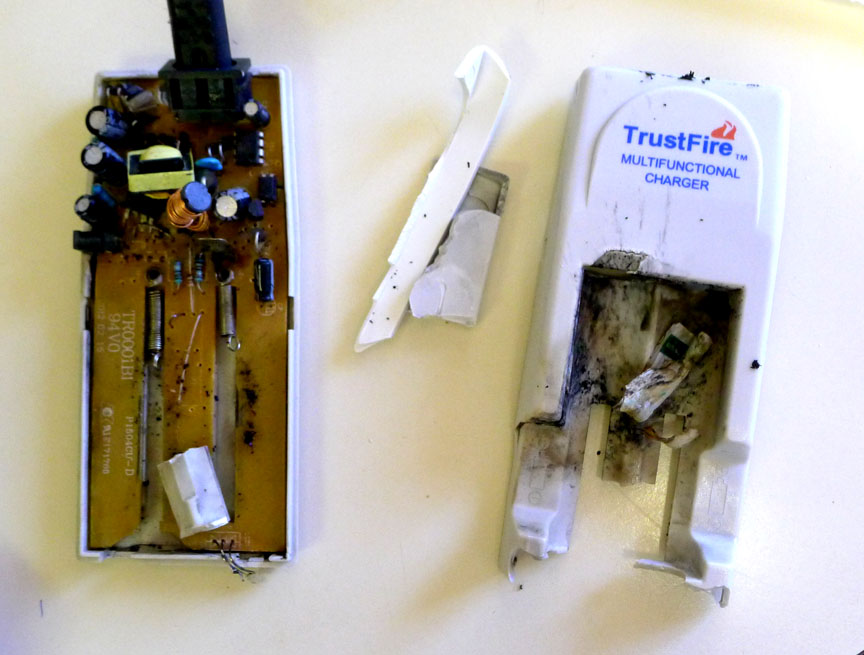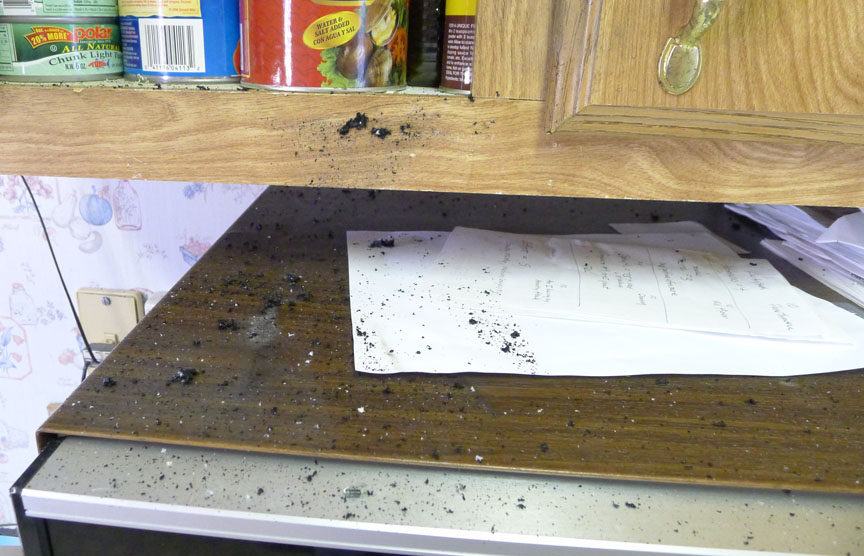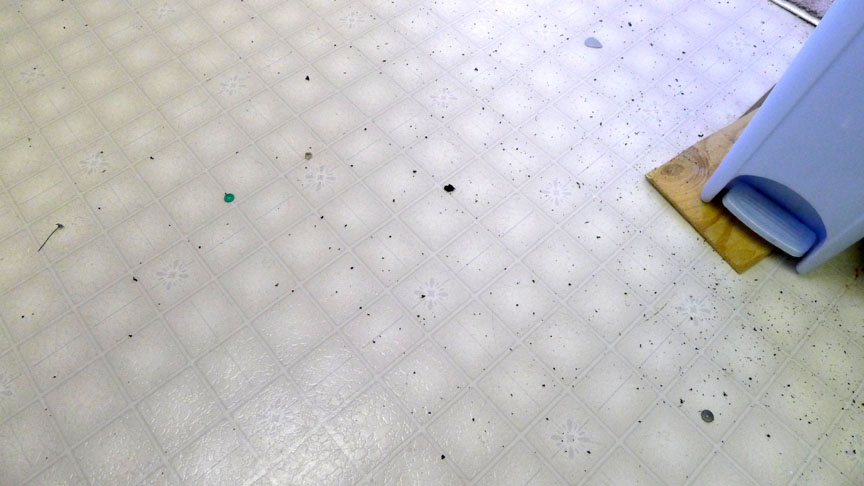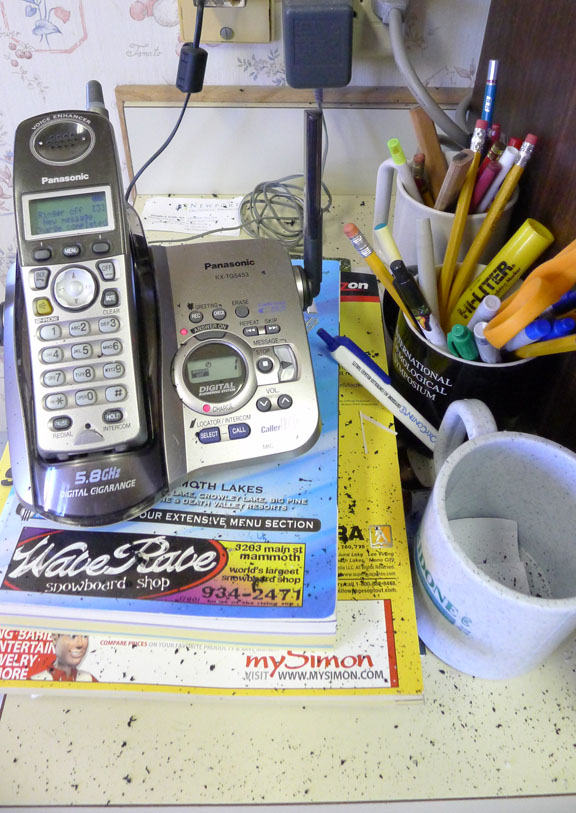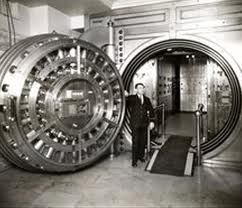I was commenting in another thread about battery explosions. I was just going to add this to that thread, but I thought everyone might want to see the pics of my fun-filled 14500 battery explosion, about 6 months ago, so I started this new thread. The battery was a 14500 gray Ultrafire which had been working just fine for 10-11 charges. Until it decided to blow up. I would like to believe that the cheapy charger just decided to deliver too many volts at some point and the fault didn’t lay in the battery itself, but I really don’t know and never will.
>>>>>If you want a good fire proof container just go to your local surplus store and buy an ammo can.
From my experience with this explosion, an ammo can might contain a 14500 explosion, but it might NOT contain the explosion from a much larger 18650 or an even larger still, 26650. Stick a stick of dynamite in an ammo can and let me know how well that “contains” the explosion. ![]()
The sound of the 14500 going off was like a stick of dynamite. Couldn’t hear anything for like an hour. I can only imagine the force of an explosion from a larger battery, although some quarter sized holes in the ammo can might vent enough of the explosion’s force to keep the can from also exploding. But without the holes …… Not something I would risk. Just a potentially bigger bomb with more shrapnel.
I cannot stress enough that this was a “real” explosion, not some vent event. Here are some pictures.
I wish I had taken one of the coffee maker, whose coffee-making days were over. ![]() But I was so shookup that I forgot. It was literally cracked in half by the force of the battery casing “bullet.” Shattered like someone hit it at supersonic speed with a 10-pound sledge.
But I was so shookup that I forgot. It was literally cracked in half by the force of the battery casing “bullet.” Shattered like someone hit it at supersonic speed with a 10-pound sledge.
Note the decimated charger and the flakes of black crap EVERYWHERE. And I mean everywhere. We were mopping it up two rooms away. It basically took a whole day. It was also stuck all over the ceiling. The flakes were not dry and could not be vacuumed but had to be wiped off with wet towels. They were gooey and sticky. Yes, we wore respirators and rubber gloves for the cleanup. Could there still be toxic bits lurking around? Absolutely, but we did the best clean-up job humanly possible. Yes, we looked online to see the toxicity of the explosion byproducts. If I had been in a city, I might have considered calling a hazardous clean-up company. But as this was in Death Valley, 90 miles round trip from the nearest podunk store and gas station, and finding and hiring a hazardous material cleanup crew would have been just way too expensive. We are alive 6 months later and suffred no ill effects from the cleanup that we could tell.
The explosion happened in the kitchen. Word to the wise: NEVER charge batteries in the kitchen.
And before everyone starts saying I should have done this or that, there was NO warning. I felt the battery (one of 2 in the charger). NO heat. Did not take a DMM reading though, something I now do regularly. Walked away and like two minutes later: KA-POW. Being involved in mining, I have heard a stick of dynamite go off when only buried in a few inches of loose dirt, and this was LOUDER.
The battery cartridge shot 30 feet across the room; shattered the coffee maker and then ricochetted into the living room, another 30 feet, rricochetted off another wall (DENTING it) and finally came to rest smoking behind a couch, where it had melted a section of the rug. No flames. I think the battery casing was just really hot. Remember that this battery casing is a pretty insignificant flimsy, light piece of metal when empty (which it was when it took off on its presumably near-supersonic tour of various rooms in my house). For it to do all this damage, it HAD to be going as fast as a bullet.
If my wife or I were in the kitchen and had been hit by that battery case, there is no doubt in my mind that it would have been similar to being shot by a bullet. If it hit me in the head, I would have been killed or really hurt.
I charge almost all my batteries outside since then. But with the 16340 (A SEPARATE overheating event, not related to this 14500 explosion) it was late at night, two nights ago, and I decided to charge it in the bathroom with the door shut. Never again. Always outside charging from now on. (The 16340 got REALLY hot because of too-high charging current, explained in the other thread).
The battery explosion happened about 6 months ago and was one of the reasons I joined this forum, to find out more li-ion info, which I did, and now charge a lot differently and much more carefully.
But when there is no visible reason for the explosion, just being careful won’t necessarily prevent another explosion. That’s why I now charge outside — to llimit damage (and cleanup).
